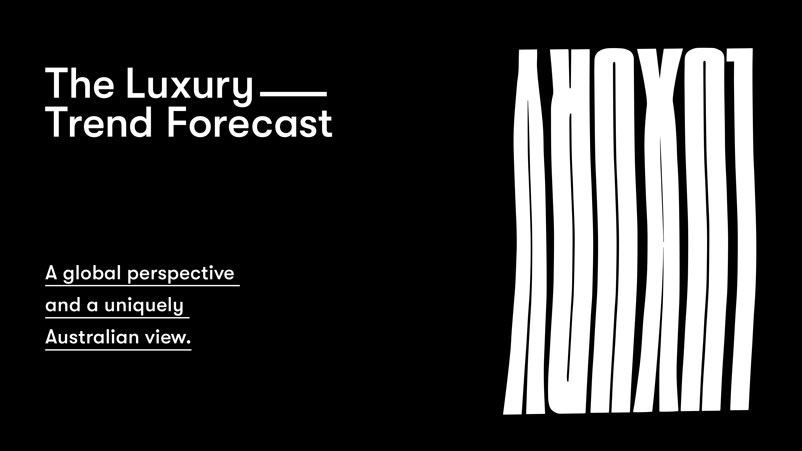Luxury brands: Subtlety is the new black

Welcome to an age of “luxury with purpose”. By 2025, 85 per cent of luxury spending will be controlled by Gens X, Y and Z.
Bauer’s luxury future trend forecast in partnership with The Future Laboratory explores both global and Australian perspectives.
The forecast reveals a new era of luxury and a shift in the consumer mindset including how expressions of wealth are becoming less overt and positioning products into everyday life is key.
“There's only 24 hours in a day so there's only so many clothes you can actually wear so anything that is additional has to be something with purpose.”
Ostentatiousness is out
The luxury consumer is being redefined: they’re discriminating, selective, ethical and inconspicuous. They aren’t just buying a brand; they are buying into their future.
There’s this groundswell of change, new ways of believing what a luxury moment or brand could be. Luxury is being challenged to balance the needs and expectations of maturing ‘luxurians’ with the values and priorities of a new younger generation while navigating the impact of digital, personalisation and a global mindset.
Changing dynamics
There are six macro trends that are shaping the luxury industry:
Altered Affluence - A collective backlash against ostentatious spending is fuelling new anxiety among luxury consumers. They’re questioning what it means to have wealth and recognise the responsibility that comes with the ability to spend, to engage, and to indulge in luxury.
Purpose Economy - A new generation of luxurians want their wealth and spending to have a greater purpose and demand that luxury brands take on new social roles and responsibilities. They increasingly expect luxury brands to step in where governments are failing, acting as forces for good in society.
Transformation Economy - An evolution of ‘the experience economy’, the transformation economy is the journey of self-improvement, or self-optimisation – towards being the best version of oneself.
Elevated Experiences - There is a greater demand for elevated service from luxury products – combined with a need for belonging to a special 'inner circle' of people who have a real knowledge of the luxury world.
Upgraded Sharing - The sharing economy model was originally created to provide communal access to experiences and services for those on a budget, but it has filtered up to the luxury sector – catering to a group who are more focused on access over ownership.
Local Prosperity - Critical for the growth of the luxury market in Australia is the amount of discretionary wealth and our commitment to spend on luxury goods. As a result, international luxury brands are continuing to enter this market and established brands are expanding their physical and online presence.
- Australian luxury market sales are forecast to grow 6-8 per cent per year through to 2024**
- The number of Australia’s luxurians with assets of $68M or more is predicted to rise by 37 per cent by 2022*
*Knight Frank ** Deloitte
“There’s a commitment to spend on luxury goods (in the Australian market), it’s never just about the high income spenders but about those who choose to invest in luxury because of the commitment and engagement with the idea of wanting to be part of a luxury lifestyle.”
There are four changing consumer dynamics that are shaping the luxury landscape in Australia: Men, women, the Chinese luxurian and youth.
Women - 52 per cent of women are now the main bread winner, they are the most educated sector of the market and their wealth is expected to grow 7% faster than men’s until 2020. (source: Roy Morgan and Boston Consulting)
Youth - Collectively, Millennials and Generation Z will represent more than 40 per cent of the overall luxury goods market by 2025, compared with around 30 per cent in 2016* (Global Powers of Luxury Goods 2018, Deloitte). Young Australian luxurians are culturally diverse, well informed, digital-native consumers who use digital technology to explore the possibilities of their next luxury purchase. For them, luxury has to be meaningful, inclusive, transparent and sustainable.
Men - A backlash against traditional features of male physicality is emerging, where softness and even blatant femininity are celebrated.
Chinese - “The success for luxury brands has been because about 60-80 per cent of spend in Australia is from Chinese. Not just tourists, but Australian-based and Australian-born Chinese as well,” according to Tim Starling, head of CBRE’s Australian retail occupier team.
Strategic implications
This new era of luxury requires brands to re-frame and re-invent services to meet evolving luxurians’ needs.
There’s an opportunity for brands to position themselves as exclusive yet open access for elevated services.
They need to demonstrate how they are building a world for the future and speak to new demographics in their language.
“While beauty was once defined as exclusively young, thin and Caucasian increasingly the runway stars/models of the moment are multi ethnic, young, old, plus sized, cisgender and transgender. Diversity was the buzz word of 2018 but the varied representation on the 2019 ready to wear runways felt for the first time like more than just a token gesture – because it largely went unnoticed.”
